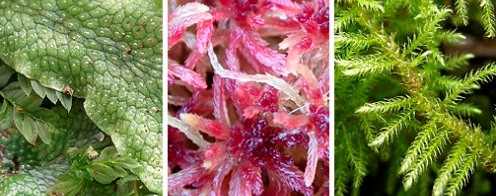
Photos: Carsten Hunding (left & right), René S. Larsen (centre)
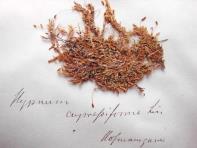
Danish specimen of Hypnum cupressiforme from the herbarium of N. Hofman Bang.
Bryophyte herbarium
Curator
Collection manager
About the collection
The herbarium includes ca. 350,000 specimens of all bryophyte groups (mosses, liverworts and hornworts) from all parts of the world. It holds the world’s largest collections of Danish (ca. 650 species) and Greenlandic (ca. 750 species) bryophytes with a coverage of 90-100%. The bryophytes of Iceland and the Faroe Islands are also well represented. The collection includes approximately 450 type specimens.
Bryophyte herbarium in numbers
- Estimated number of specimens/collections: Approx 340,000 plus 100,000 not registered
- Types: Approx 450
- Percentage databased: c. 5%
Strengths
- Mexican liverworts collected by F.M. Liebmann from 1841-1843.
- Nordic and Greenlandic liverworts collected by Kell Damsholt, from 1963 [?]-present.
- Scandinavian (mostly Danish) bryophytes collected by Christian Erasmus Otterstrøm Jensen from 1880-1940, including several types.
- Arctic bryophytes collected by Kjeld Holmen from 1948-1974.
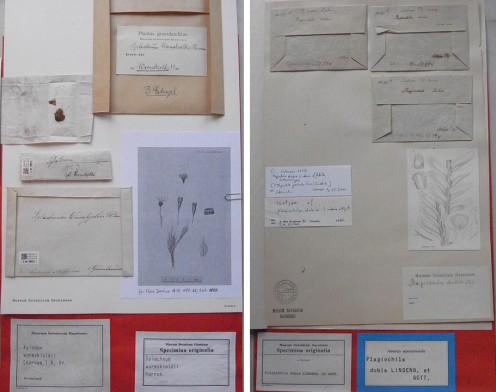
Types of Splachnum workskioldii from Greenland and Plagiochila dubia collected by F. M. Liebmann in Mexico (herbarium of C. M. Gottsche).
Important subcollections
- Frederik Michael Liebmann (1813-1856): Bryophytes from Mexico.
- Christian Erasmus Otterstrøm Jensen (1859-1941): Denmark, Greenland, Faroe Islands, Scandinavia, Northern Europe. The collection includes several types.
- Kjeld Axel Holmen (1921-1974): Bryophytes from Greenland, Arctic North America and Denmark
- Kell Damsholt (collected c. 1963-): Liverworts, mainly from Scandinavia and Greenland.
- Auguste François Marie Glaziou (1833-1906): Brazilian bryophytes, including several types.
- Jens Vahl (1796-1854): Bryophytes from Greenland and other Arctic localities. Historical value.
- Thomas Jensen (1824-1877): Bryophytes from Denmark.
- J.F. Schouw (1789-1852) Bryophytes, e.g. 93 Hypnum taxa. Historical value.
- Nicolaus Hofman Bang (1776-1855). Bryophytes from Europe.
In Hepaticae, the collection holds e.g. a large collection by Kell Damsholt of Scandinavian and Greenlandic liverworts collected from 1963 and onwards. Important publications include “The Hepaticae of West Greenland from 66°N to 72°N” (1974) by R. M. Schuster and K. Damsholt, “Illustrated Flora of Nordic Liverworts and Hornworts” (2002) by K. Damsholt, and “The Liverworts of Greenland” (2013) by K. Damsholt.
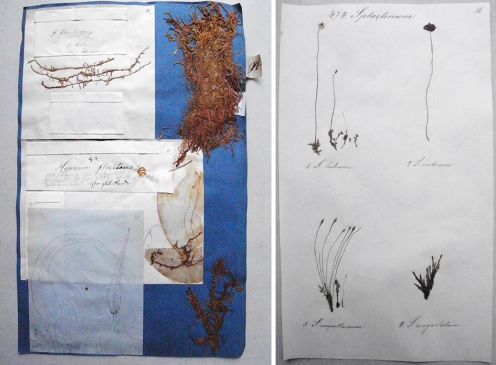
The herbarium of N. Hofman Bang. Specimens and illustration of Drepanocladus fluitans and album presentation of Splachnaceae (dung mosses).
Some of the exsiccatae included in the collection
- E. Bauer. 1903. “Musci Europaei Exsiccati”: Mosses of Central Europe
- F. Didrichsen. “Musci & Hepaticae”: Historical value, Book with beautifully arranged specimens.
- D. Dietrich. 1851. “Sammlung Deutscher Laubmoose, Lebermoose and Flechten”.
- N. Hofman Bang. 1868. “Musci frondosi”. Historical value
- O. J. Freuchen. 1821. “Musci frondosi et hepatici Hafniæ”. Historical value
- J. W. Hornemann. “Musci & Hepaticae”. Historical value
- J. A. Hose. 1799. “Herbarium Vivum Muscorum Frondosorum”. Historical value
- F. G. Kneif & Ch. P. W. Mærker. 1825-1832. ”Musci Frondosi”. Historical value
- H. C. Lyngbye. 1813. “Musci Frondosi”. Historical value.
- P. Reinsch. 1872. “Muscorum Frondosorum um Europae mediae”
- C. F. Thedenius. 1838. “Musci Sveciae Exsiccati”. Historical value.
- H. Wagner. 1853-1860. “Cryptogamen Bielefeld”. Historical value.
- J. E. Zetterstedt. “Grimmieæ et Andreææ Exsiccatæ. Swedish bryophytes collected 1855-1859.
History
One of the oldest mosses in the collection is a specimen of Dicranum elongatum (Danish: lampevægemos) collected in Greenland by Poul Egede (son of Hans Egede). Serious bryological research in Denmark began with Thomas Jensen (1824-1877) and his publication “Bryologia Danica” in 1856 which was based on his own collections and material received from other botanists like Caroline Rosenberg and Morten Thomsen Lange. In 1866 he published “Conspectus Hepaticarum Daniæ” which laid the basis for the knowledge on Danish liverworts. Later, the Danish pharmacist Christian Jensen (1859-1941), increased our knowledge of the bryophytes of Denmark, Scandinavia and the Faroe Islands with his extensive collections and the floristic works “Danmarks Mosser” (1915-1923) and “Skandinaviens Bladmossflora” (1939). The bryophyte flora of Greenland has also been well explored and is represented by the early collections of Jens Vahl and the subsequent collections of Kjeld Holmen, Kell Damsholt, Jette Lewinsky and Gert Mogensen.
Former curators:
- Kjeld Holmen (end of 1940s to 1974)
- Gert Steen Mogensen (ca. 1975-2002)
- Ruth Nielsen (ca. 2002-2010)
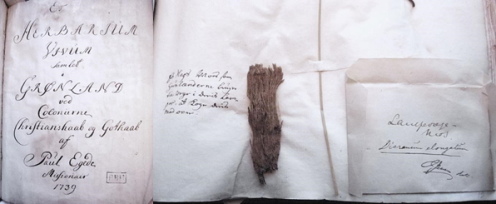
Dicranum elongatum from Greenland from the Poul Egede book herbarium.
Digital catalogues, not available online:
- Bryophyte database
- K. Damsholt, Danish liverworts
- Type database
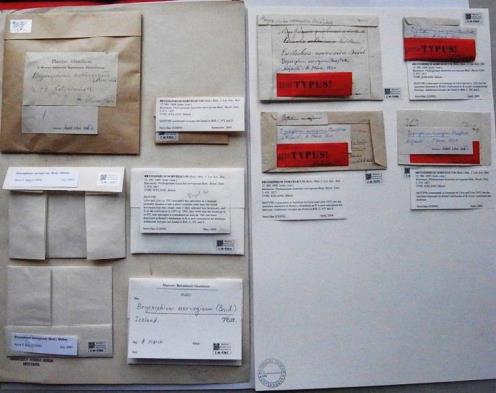
Isotypes of Phyllogonium norvegicum (= Bryoxiphium) collected by A. Mørch in Iceland in 1820
